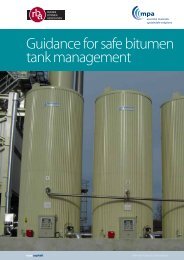GUIDE TO SAFE DELIVERY OF - Refined Bitumen Association
GUIDE TO SAFE DELIVERY OF - Refined Bitumen Association
GUIDE TO SAFE DELIVERY OF - Refined Bitumen Association
You also want an ePaper? Increase the reach of your titles
YUMPU automatically turns print PDFs into web optimized ePapers that Google loves.
18 Guide to Safe delivery of <strong>Bitumen</strong> uK edition<br />
4<br />
Operation &<br />
maintenance<br />
of storage<br />
tanks and<br />
pipework<br />
4.6 Tank design & use<br />
Legislation/source documentation<br />
References 2, 15<br />
Guidance<br />
4.6.1 If customer tanks are fitted with inlet/fill pipes that pass through the top of the<br />
tank and extend to the bottom of the tank (to minimise oxidation of the bitumen<br />
during circulation), the inlet pipe must be slotted or fitted with an alternative<br />
device to prevent spillages resulting from siphoning at the end of the delivery.<br />
4.6.2 All access ladders and walkways on tank roofs must be fitted with suitable<br />
guards to prevent falls.<br />
4.6.3 Where other product storage tanks, e.g. bitumen emulsion, kerosene, etc. are<br />
present, all supply and return pipework must be segregated from the bitumen<br />
pipework system and identified.<br />
4.6.4 Where out of service bitumen tanks are being returned to service after<br />
maintenance or long interruption, clear procedures must be developed to<br />
ensure that the tank is safe to operate and is free of water.<br />
4.7 Storage temperature<br />
Legislation/source documentation<br />
References 13, 18<br />
Guidance<br />
4.7.1 For recommended operating and maximum storage temperatures please refer<br />
to the supplier’s recommendations.



